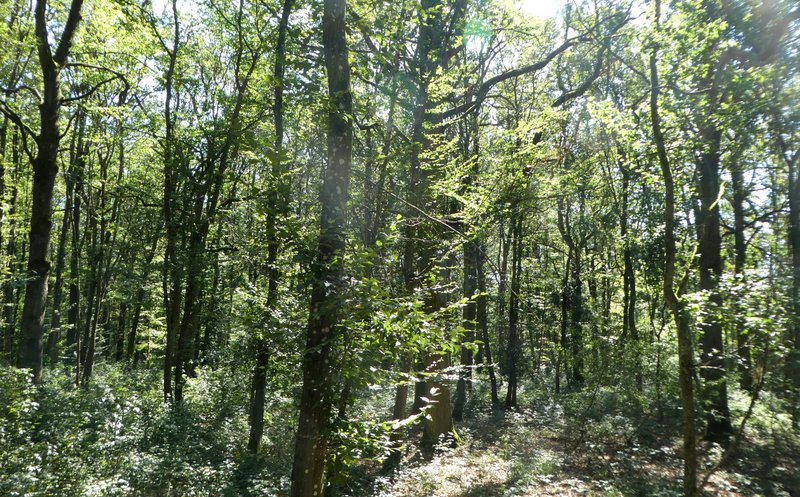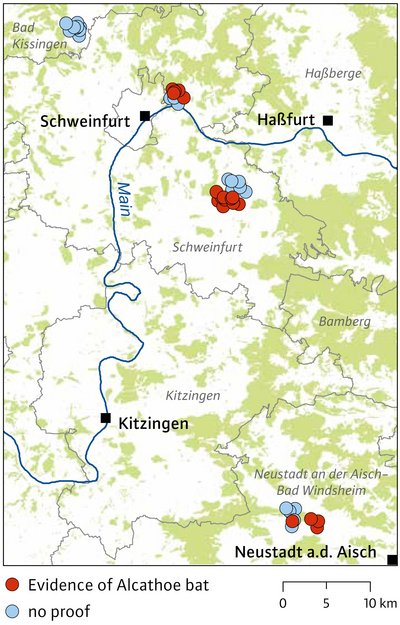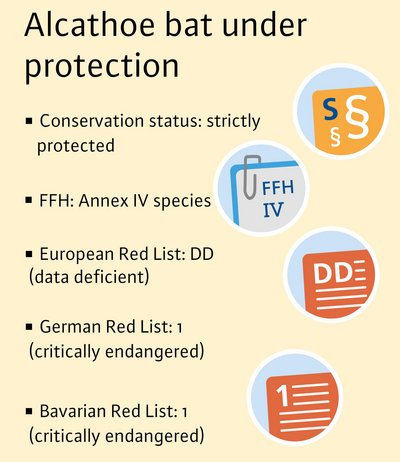The Alcathoe bat has been with us for a while, but was just not recognised as a separate species. It is morphologically so similar to the two native whiskered bats already known here (Myotis mystacinus and Myotis brandtii), that even specialists did not notice the small differences for decades.
Discovery of the species
The Alcathoe bat was discovered and first described as a separate species in Greece in 2001, by the renowned Erlangen bat professor Otto von Helversen and colleagues. The research team caught animals that were hunting in remote, moist forest valleys, and were later able to prove through molecular genetic studies that it is a separate species. It was given the name Myotis alcathoe in reference to a figure from Greek mythology – the “nymph” bat. The story goes that the nymph Alcathoe refused to attend a festival of the wine god Dionysus and was turned into a bat as a punishment.
After the discovery of the species in Baden-Württemberg in 2005 and somewhat later in Hesse, Saxony, Saxony-Anhalt and Thuringia, it was only a matter of time before the Alcathoe bat was also detected in Bavaria. In 2012, this was finally the case, when Alcathoe bats were found in net catches in the Forchheim municipal forest and shortly afterwards in the Sailershauser forest in the Hassberge district. In the following years, a number of projects were initiated in Bavaria and some other federal states to find out more about the distribution of this “new” species and its biology and ecology. The fact that this species' orientation calls are very distinctive and easily distinguishable from other Myotis species was and is an enormous help. This means they can be recorded and reliably identified with sound recording devices.
Distribution in Bavaria and habitat
In Germany, the Alcathoe bat is considered to be one of the rarest bat species. It is very reclusive, which is why knowledge about its distribution in Bavaria is still limited. Earlier studies show its main area of distribution to be in old deciduous forests in northern Bavaria. There is a complete lack of evidence of the species south of the Danube - despite intensive searches in forests that are well suited as habitats.
According to Dietz and Kiefer (2014), the Alcathoe bat is the European bat most adapted to primeval forest-like conditions. This has been confirmed by numerous telemetry studies, net catches and listening boxes in Austria, France, the Czech Republic, Slovakia and the German states of Baden-Württemberg, Hesse, Thuringia, Saxony and Bavaria, among others. According to these, evidence of the Alcathoe bat is mainly concentrated in old to very old deciduous forests - especially forests with a high proportion of oak or beech, and often in the vicinity of small, permanent flowing or still waters (Figure 2). The maternity and daytime roosts of the animals are almost exclusively located in the canopy of old deciduous trees (especially oaks), under protruding bark, cracks in the trunk, small rotting areas and in niches on broken branches. The species is thus usually classified as a crevice dweller.
Telemetry studies in Baden-Württemberg have shown that maternity colonies in particular usually change roosts daily, but at the latest on the third day. This is probably associated with the avoidance of parasites and predators, ambient temperature, and the low durability of the roosts. A forest should accordingly have a high number of potential roosts to be suitable as a habitat for the Alcathoe bat. Very little is known about the hibernation roosts of this species. So far, only single animals have been found in underground roosts (caves, tunnels, cellars). It probably hibernates in tree cavities in the forest.
Hunting strategy and spatial use
The assumption up to now, that the species hunts mainly in the canopy, was not confirmed by a study carried out by the State Office for the Environment. Parallel call surveys carried out in the canopy and near the ground did not reveal any significant differences in activity. This indicates that the animals use the entire range of different strata in the forest. Net catches also showed a focus of activity in the vegetation on the banks of water bodies not far from the roost tree. The Alcathoe bat hunts very close to the vegetation (edge space), but does not pick up its prey from the substrate (gleaning), as the Bechstein's bat does, for example. Instead, it catches it in flight (aerial-hawking). The species is therefore assigned to the guild of “edge space aerial foragers”. The Alcathoe bat feeds exclusively on insects and arachnids. Examinations of faecal samples indicate a clear preference for mosquitoes, small butterflies and web-winged moths in its range of prey.
The activity radius of the Alcathoe bat is small. Their hunting grounds are in the immediate vicinity of their roost. In their telemetry studies, Dietz and Dietz (2015) found that the animals spent more than half of their hunting time within 600 m of the respective roost, and that the average size of the hunting habitat of an individual animal was about 100 ha. Other sources give distances of up to 1,500 m or 3,000 m to the hunting grounds.
Confirmed detections in the LWF bat study
In 2020 and 2021, the Bavarian State Institute for Forests and Forestry (LWF) conducted call surveys in several oak-rich mixed deciduous forests as part of the study “Bat activity in mixed oak stands in Middle and Lower Franconia affected to different degrees by climate change”.
Among other things, it was to be investigated whether the use of plant protection products in stands heavily infested with the gypsy moth has an effect on “bats” as a non-target organism group. For this purpose, batcorders were installed in a total of 39 forest stands in four study areas to record bat activity. The recordings were made once a month for one night in the period from April to September. A surprising coincidental observation was made: In three of the four survey areas, at 19 batcorder sites, the rare Alcathoe bat was detected; namely on the sites near Mainberg, near Sulzheim and north-east of Ullstadt (Figure 3). Of all 13 bat species recorded, the Alcathoe bat displayed the third highest total activity (measured in terms of duration of recorded calls in seconds), after the common pipistrelle and the soprano pipistrelle. The intensity of calls at a site in the FFH area "Dürrfelder und Sulzheimer Wald” north of Gerolzhofen even suggests that there is a maternity roost there.
The detection sites corroborate previously acquired knowledge on the habitat requirements of the species: They require forest stands characterised by high proportions of oak (between 65 and 100 % of the growing stock). The majority is at the maturation stage - the estimated age of the dominant tree layer is between 120 and 150 years. Almost all stands are structurally rich and have several layers. They are predominantly closed-canopy forests with an estimated canopy cover (tree layer) of between 80 and 100 %. There are smaller watercourses or still waters within easy reach.
Summary
The Alcathoe bat is considered to be one of the rarest bat species in Germany. Its distribution, biology and ecology have not yet been extensively researched. The current state of knowledge is that it occurs in old to very old deciduous forests, uses small cavities and crevices in the crowns of old deciduous trees as daytime refuges and maternity roosts, and that it has a relatively small radius of action. In a pilot study carried out by the Bavarian State Institute of Forestry (LWF) in deciduous forests in Lower and Middle Franconia, researchers were surprised to detect the species at 19 of a total of 39 batcorder sites. Almost all detection sites confirm the habitat requirements of the species as supposed to date.





